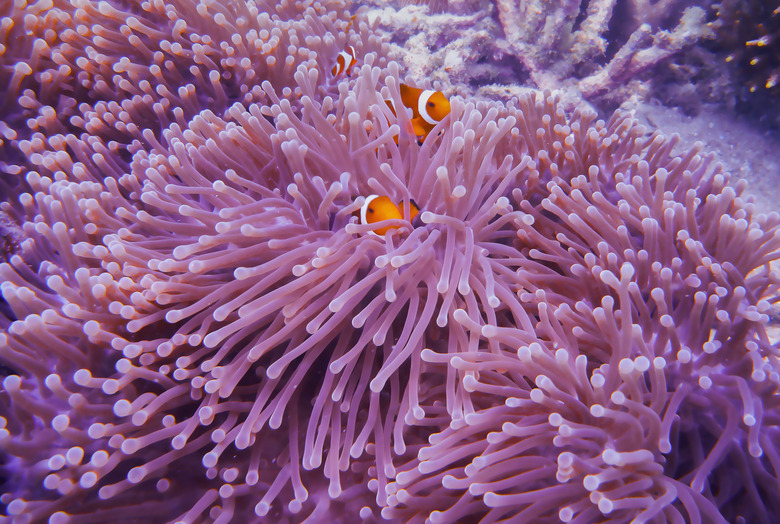Basic Characteristics Of Cnidaria
More than half a billion years ago, a jellyfish sank through warm seawater, settling into the fine mud at the bottom. Subsequent layers of mud buried the jellyfish along with many other soft-bodied invertebrates. Over time the fragile body decomposed, leaving only an imprint behind. In 1909, Charles D. Walcott discovered the secret hidden in the now-lithified mud: a snapshot of that world, including that ancient member of the phylum now called Cnidaria.
TL;DR (Too Long; Didn't Read)
Cnidarians share several basic characteristics. All Cnidaria are aquatic, mostly marine, organisms. They all have tentacles with stinging cells called nematocysts that they use to capture food. Cnidarians only have two body layers, the ectoderm and endoderm, separated by a jelly-like layer called the mesoglea. Most Cnidarians have radial symmetry. Most Cnidarians have complicated reproductive cycles that include an asexual stage and a sexual stage. Some Cnidarians are completely mobile while others are completely sessile, but most have both mobile medusa and sessile polyp stages in their life cycles.
Classes of Cnidarians
Classes of Cnidarians
The four recognized classes of Cnidaria are: Hydrozoa, Cubozoa, Scyphozoa and Anthozoa. Class Hydrozoa contains tiny predatory animals which live in fresh water (hydras) or marine environments. Most Hydrozoa make calcite shells. Some Hydrozoa live singularly while others live in colonies. Class Scyphozoa contains jellyfish, All Scyphozoa live in the ocean. Scyphozoa have a short polyp phase but live most of their lives in their medusae form. Class Anthozoa includes sea pens, sea anemones and corals. Anthozoa have no medusae stage and all live in marine environments. Many fossil Cnidaria are members of Anthozoa. Class Cubozoa contains box jellyfish, which differ from true jellyfish in that they have a primitive nervous system and eyes. Among the most venomous animals on Earth, box jellyfish stings can be fatal to humans, especially children. While all Cnidarians share many characteristics, each class displays some unique characteristics as well.
Body Symmetry
Body Symmetry
The majority of Cnidarians share the characteristic of radial symmetry. Radial symmetry means symmetry around a center point such that any line drawn through the center of the organism divides the body into mirror images. A jellyfish, for example, viewed from above has radial symmetry. Many Cnidarians also exhibit a second axis of bilateral symmetry, and some Cnidarians only exhibit bilateral symmetry. Bilateral symmetry means a single plane drawn through the middle of the organism will show mirror images across the plane. More complex, "higher" order organisms all share the characteristic of bilateral symmetry. The class Cnidarian contains members with radial symmetry and members with bilateral symmetry as well as members that exhibit both symmetries. Cnidarians therefore may provide clues and insights into the development of more complex body structures.
Body Structure
Body Structure
All Cnidarians share particular trait: tentacles with stinging nematocysts. The nematocysts act like tiny harpoons, reacting to stimuli by hurling out small stinging cells that both poison and hook potential prey. The thread attaching the stinging cell to the Cnidarian then retracts, drawing the victim back to the main body of the Cnidarian to be eaten or stung to death. Like other invertebrates, Cnidarians lack bones and a central nervous system. Instead they have a nerve net. Cnidarians have only two body layers, the endoderm, and the ectoderm. Between the two body layers lies the jelly-like mesoglea. The mesoglea acts as little more than a glue in some Cnidarians while making up most of the animal, as in the case of the jellyfish, in other Cnidarians. Cnidarians all have a main body cavity with only one opening, the mouth, which is surrounded by tentacles. In the sessile, or non-mobile, forms, the mouth points up. In the mobile medusa form the mouth points down. The muscles of the body wall help a medusa swim, and the tentacles of anemones and coral move using hydrostatic action.
Reproductive Cycle
Reproductive Cycle
Cnidarians have complex reproductive cycles. Many cnidarians have an asexual stage, usually in the form of asessile polyp which asexually produces other polyps and medusae. The free-swimming medusae reproduce sexually. The medusa releases eggs and sperm into the water where they combine to form zygotes. The zygote develops into a larva that settles on a substrate and becomes a polyp. The polyp produces more polyps and medusae and the cycle begins again. But there are some types of Cnidarians, like sea anemones and corals, that lack the medusa stage. They simply release eggs and sperm into the water. The reproductive cycle of true jellyfish also varies with environmental conditions. Cnidarians also can regenerate when broken apart when attacked by predators or divided by accident.
Capturing Food
Capturing Food
The carnivorous Cnidarians use their stinging tentacles to capture prey. Because sessile Cnidarians like corals and sea anemones don't move and in general jellyfish have limited power to move independently through the water, their prey, like small fish or crustaceans, comes to these Cnidarians through misadventure. The box jellyfish swim relatively quickly so they seem more capable of hunting their prey. Some sessile Cnidarians seem to be able to absorb dissolved organic material directly from the water but research continues into this possibility.
Cite This Article
MLA
McKanic, Arlene. "Basic Characteristics Of Cnidaria" sciencing.com, https://www.sciencing.com/basic-characteristics-cnidaria-8399110/. 27 April 2018.
APA
McKanic, Arlene. (2018, April 27). Basic Characteristics Of Cnidaria. sciencing.com. Retrieved from https://www.sciencing.com/basic-characteristics-cnidaria-8399110/
Chicago
McKanic, Arlene. Basic Characteristics Of Cnidaria last modified August 30, 2022. https://www.sciencing.com/basic-characteristics-cnidaria-8399110/
